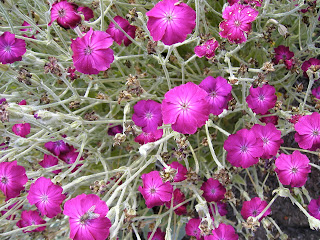



We all start thinking about how much to be watering our lawns and gardens when the weather gets hot.
The rule of thumb that I use is: Lawns 1 inch per week, a little more if it's really hot and breezy.
Flower beds 2 inches per week.
I like to water the entire yard twice a week and then hand water the beds. I love being out there to hear the birds and see what's happening in the garden.
When to water? It's best to water in the cooler parts of the day. Mornings or evenings, depending on your schedule. Shady areas can be watered at other times as well. One thing to avoid is the scorching hot sun. If water lands on the leaves and is quickly evaporated off, the leaves can scorch. Unsightly and harmful to the plant. Resist the urge to run out after work on a hot day to give your sunny beds a drink. Once it cools down, it's safe to water them.
How much to water?
The old tuna can rule is helpful. By placing an empty tuna can in your lawn you can measure how much water the lawn is getting. My low level sprinklers throw about one half inch of water in 20 minutes. So, I move my hose every 20 minutes with the reminder of a timer that I set.
What sort of sprinkler to use?
The traditional broadcast sprinkler with the arm that moves back and forth is very pretty to watch, great for the kids to run in but wastes quite a bit of water. (See lower right photo) A lot of the water evaporates by this method of delivery. At your local hardware store you will find low level sprinklers that are very rugged. (Upper left photo is a close up, lower left shows it in use) They cover a smaller area but work great. Since there are no moving parts they last just about forever too!
What about the cost?
I have about a quarter acre lot and lots of flower beds. My vegetables are now in raised beds. These dry out quickly and need daily or even twice daily watering. My water bill will increase by 50% this summer. If it's really hot it could be double. To me, it all evens out on the utility bill side. Less electricity, more water. Plus we get all the beauty and bounty from the gardens.
What if the lawn has turned brown?
If your lawn has turned brown, it is signaling to you that it did not receive enough water and has gone into dormancy. This will not hurt the lawn and you will see it green up when the fall rains return. I would avoid really heavy use of the area however, since it can't recover from say a football game. The roots could be damaged and you may end up with bald spots next fall, a great place for weeds to take hold.
I have seen lawns "watered back to life" in the middle of summer. It takes a LOT of water to get there. In my opinion, it's not worth the effort. If you really like a green lawn, it's important to stay ahead of the game. When the spring rains taper off, make sure you start watering so that it gets the needed one inch per week. Waiting for brown spots to show up means you are too late.
Good luck with your gardening!

 Great companion plants that will do great together! Shasta Daisies in the back, Rose Campion in the next row, Coreopsis and Centaurea Montana staggered in the front. Red, white, blue, yellow---all bold colors that will look fantastic for weeks. My previous posts extolled the virtues of these four perennials. If you have a nice sunny location you will get excellent results by following this rough sketch. Think massing and grouping, not straight lines. If you are purchasing plants, go for 1 gallon or even 2 gallon sizes to get them to fill in quickly. Otherwise, 3 inch and 6 inch clumps from a fellow gardener will work perfectly!
Great companion plants that will do great together! Shasta Daisies in the back, Rose Campion in the next row, Coreopsis and Centaurea Montana staggered in the front. Red, white, blue, yellow---all bold colors that will look fantastic for weeks. My previous posts extolled the virtues of these four perennials. If you have a nice sunny location you will get excellent results by following this rough sketch. Think massing and grouping, not straight lines. If you are purchasing plants, go for 1 gallon or even 2 gallon sizes to get them to fill in quickly. Otherwise, 3 inch and 6 inch clumps from a fellow gardener will work perfectly!















